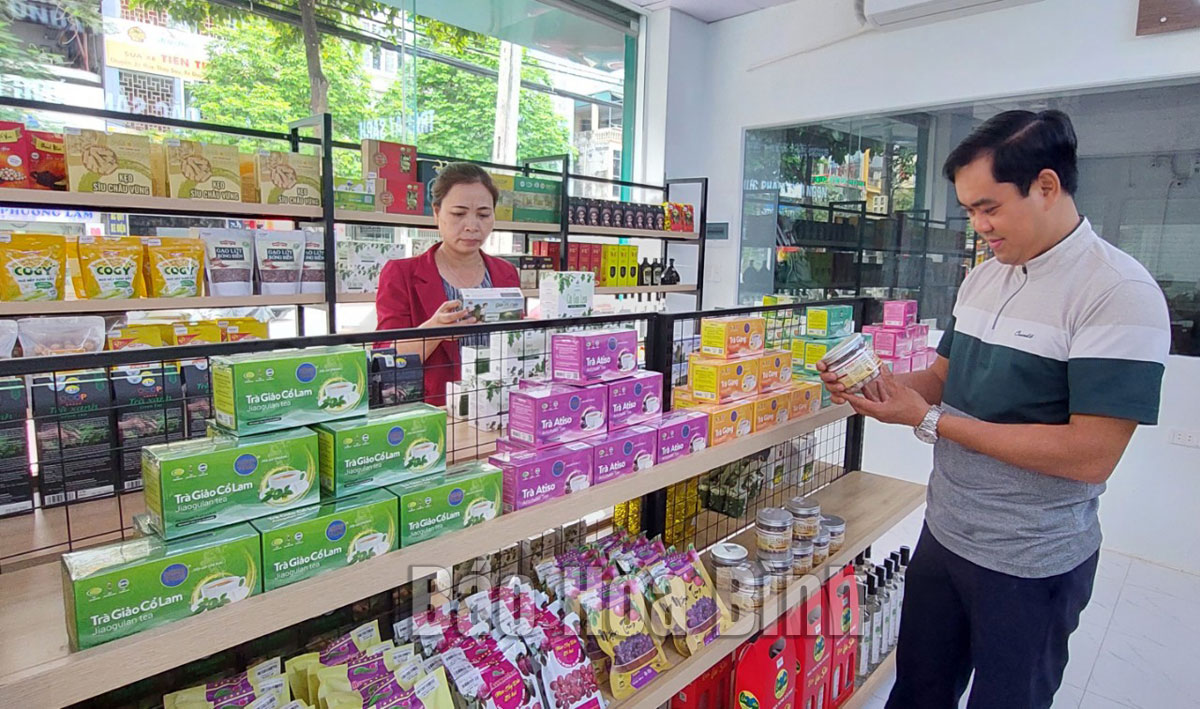
(HBO) – In the period of post-pandemic socio-economic recovery and development, the promotion of the campaign of "Vietnamese people prioritise Vietnamese products” has become significant. The campaign has been actively responded in Hoa Binh.

Customers at a shop introducing and selling OCOP products of
Hoa Binh and other localities on Cu Chinh Lan Street of Phuong Lam ward, Hoa
Binh City.
With an aim to introduce, promote and contribute to the sale
of OCOP and handicraft products of Hoa Binh to customers inside and outside the
country, since April 2022, Hoang Viet Ha, a resident of Thinh Lang ward of Hoa
Binh city, has set up a business model called "Hoa Dat Muong (flowers of Muong
land) and offer gift sets comprising the products to customers. In April alone,
Ha sold nearly 900 gift sets.
Hoa Binh has set up a steering committee on the
implementation of the campaign with 12 members from local departments,
agencies, socio-political organisations and local businesses.
According to Bui Tien Luc, head of the provincial Party
Committee’s Commission for Mass Mobilisation, Chairman of the Hoa Binh
Fatherland Front Committee and head of the steering committee, the campaign
aims to raise public awareness of domestic production capacity and the quality
of products of Vietnam and Hoa Binh in particular.
He said that in order to effectively implement the campaign,
the province has called for the engagement of local businesses and residents in
the work, while introducing traditional craft villages and typical products of
the province, and strictly handling cases of piracy, counterfeit and poor
quality commodities to win consumer confidence.
At the same time, the provincial Department of Industry and
Trade has also carried out various activities to implement the campaign,
including trade fairs and promotion, and supply-demand connection activities.
A survey showed that the rate of Vietnamese goods available
in local shops, supermarkets and distribution channels has reached at least 80
percent, said Luc, who also stressed the need for more attention to bringing
more local products to other localities and countries./.
According to data from the Hoa Binh Provincial Party Committee, the industrial production index for the first six months of 2025 is estimated to have increased by 20% compared to the same period last year. This marks the highest year-on-year growth rate for this period since 2020.
In the first six months of 2025, Hoa Binh province’s export turnover was estimated at 1.145 billion USD, marking an 18.11% increase compared to the same period in 2024. Import turnover was estimated at $ 804 million, a 17.15% increase, which helped the province maintain a positive trade balance.
The lives of the ethnic minority farmers in Tan Lac district have gradually improved thanks to the new directions in agricultural production. This is a testament to the collective strength fostered through the professional associations and groups implemented by various levels of the district’s Farmers’ Union.
With the motto the "product quality comes first,” after nearly one year of establishment and operation, Muong village’s Clean Food Agricultural and Commercial Cooperative, located in Cau Hamlet, Hung Son Commune (Kim Boi district), has launched reputable, high-quality agricultural products to the market that are well-received by consumers. The products such as Muong village’s pork sausage, salt-cured chicken, and salt-cured pork hocks have gradually carved out a place in the market and they are on the path to obtaining the OCOP certification.
In the past, the phrase "bumper harvest, rock-bottom prices" was a familiar refrain for Vietnamese farmers engaged in fragmented, small-scale agriculture. But today, a new spirit is emerging across rural areas of Hoa Binh province - one of collaboration, organisation, and collective economic models that provide a stable foundation for production.
Maintaining growing area codes and packing facility codes in accordance with regulations is a mandatory requirement for agricultural products to be eligible for export. Recently, the Department of Agriculture and Environment of Hoa Binh province has intensified technical supervision of designated farming areas and packing facilities to safeguard the "green passport" that enables its products to access international markets.



